How to take photos inside a fridge or oven or other constricted space
Photographing inside a constricted space such as an oven or washing machine can give an unusual view that you don't normally see. I don't mean taking a photo from the outside looking into your oven or washing machine, but rather a photo taken from the inside, looking out.
There are lots of subjects that can be used for this type of photo. To give some examples:
- Fridge
- Freezer
- Microwave
- Oven
- Dishwasher
- A shelf inside a cupboard
Any small space that provides an interesting or unusual perspective will work well really.
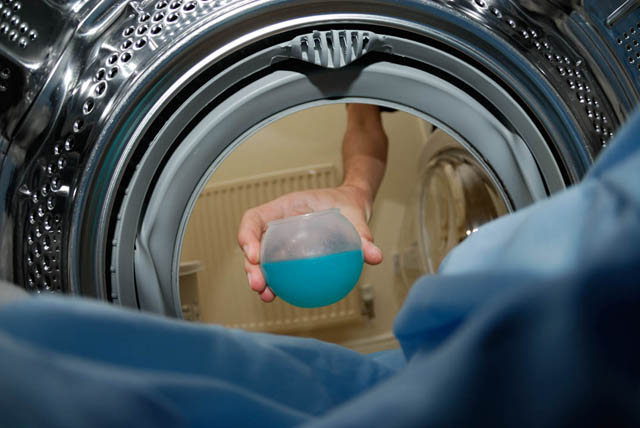
Putting detergent in the washing machine
To make a photo like this, you need a camera with a very wide angle lens. Because the space is so constricted, a lens that is not wide angle will not likely capture enough of the interior space for an interesting photo.
A fisheye lens gives a very large field of view (often around 130° to 180° horizontally), and works very well for this kind of photography. Standard wide angle lenses (e.g. 7-14mm for micro 4/3, 10-20mm for APS-C cameras, and 14mm for full frame cameras) should work reasonably well also.
If you have a compact camera, you can create a cheap fisheye lens by using a door peephole. You can find lots of information on this by just searching the web for "Fisheye peephole". Or see this Flickr group: Peephole fish eye.
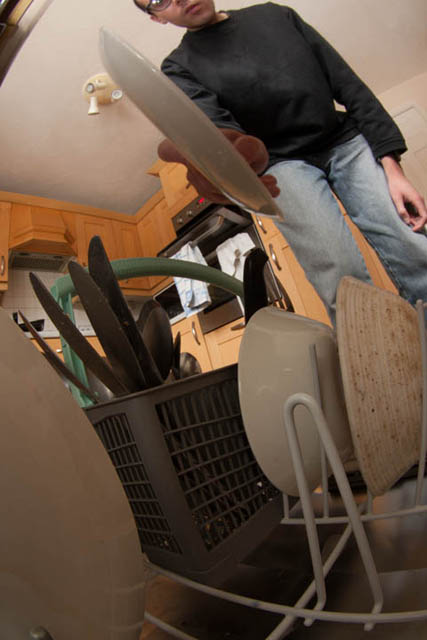
Putting a plate in the dishwasher
Depending on where you are shooting, you will probably need some extra light as well. Most constricted places are quite dark, and if you are shooting from inside a fridge with the door closed, there won't be any light at all. Lighting the scene is mostly a bit of trial and error.
Continuous lighting e.g. an LED torch or small LED light panel will usually necessitate a longish exposure, e.g. over 1 second. If you are using flash as your primary light source, this will allow you to use a short exposure. Flash is better if you want to include yourself in the image (e.g. opening the fridge door) as during a long exposure you are likely to move a little bit resulting in slight blurring.
The features of your camera partly determine how easy it is to shoot inside a constricted space. If your camera has an LCD screen that can be tilted out to the side or above the camera, this is very useful. It allows you to take test shots without having to remove the camera after each shot to check the image on the rear LCD.
Even better is if your camera has Wi-Fi and allows you to control it wirelessly from your phone. Not only can you see how the photo turns out easily, you can also adjust the camera settings without having to even touch the camera. This is very useful if you have placed objects in front of the camera, making it tricky to get to the camera without re-arranging the scene.
Sadly, my camera doesn't have a tilting LCD or Wi-Fi (though I wish it did). To shoot inside the fridge I used a tablet computer with a USB cable connected to the camera that allowed me to view the images and adjust settings without touching the camera. Then I removed the cable from the image in post-processing. For the other photos I just removed the camera after each shot, checked the image and adjusted settings, then put it back.
Check to see how the image is focused. Generally it is a good idea to switch the camera to manual focus, and then set the focus near the closest focusing distance. You will likely have things very close to the camera, and so you want these things to be in focus.
Here is a setup photo that shows the how I took the buns cooking in the oven:
I used an LED light for this photo, shining up towards the roof of the cooker. The idea being that the light will then reflect back from the top of the cooker. The top of the cooker is painted in quite a dark color, and is not very reflective, so a long exposure time was needed (20 seconds at ISO 200).
I wanted to use quite a warm color inside the cooker, to give the impression that it was actually switched on and cooking the buns, so I wrapped my light in an orange plastic bag. The light needed to be placed right at the back of the cooker near the camera, as I didn't want the light to appear in the shot.
I used a fisheye lens and focused it to near its minimum focusing distance, then placed the camera right near the back of the oven. I put some already cooked buns on a tray, then put these in the oven. The end of the tray sticks underneath the camera lens a little bit.
The camera was set to self timer drive mode. This meant I could press the shutter button, then have time to close the oven door and move out of the way before the camera took the actual photo.
When the photo had been taken, I had to remove the tray and camera from the oven and then check the photo on the camera's rear LCD. A bit of a do, and it took a few tries to get the final photo, which I am reasonably happy with.
The trick of coloring your light can be a good way to make the image appear as if the device you are taking the photo in is switched on. To light the microwave shot below I used flash, with a warming gel on the flash to give a warmer color temperature. This more accurately represents the color of the light from the bulb in the microwave when it is actually switched on, and so gives the impression that the microwave is switched on.
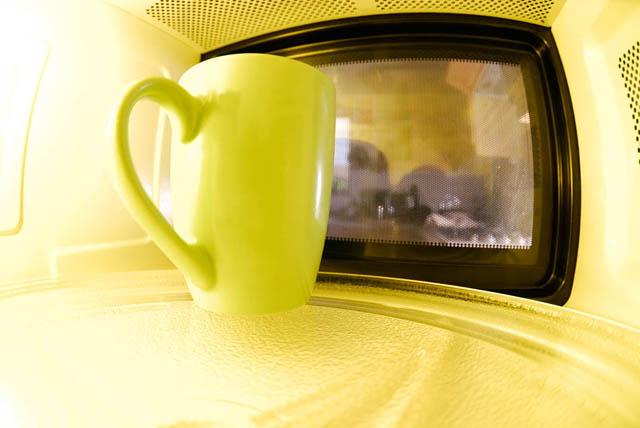
Mug of drink being warmed in the microwave
I certainly would not recommend putting your camera in an oven or microwave when they are actually switched on. A fridge shouldn't cause any problems when on, and a freezer should be okay so long as you don't leave the camera in there for very long.
If you're looking to create the impression that the camera is somewhere wet, such as inside a washing machine or dishwasher when switched on, you can try wetting everything down before you put the camera in place. Maybe get a few suds and place them in the scene. You can even carefully apply a drop or two of water to the front of the camera's lens to make it look like some of the water has splashed on the camera.
So, for some unusual perspectives, try putting your camera in a small area and give constricted space photography a go.
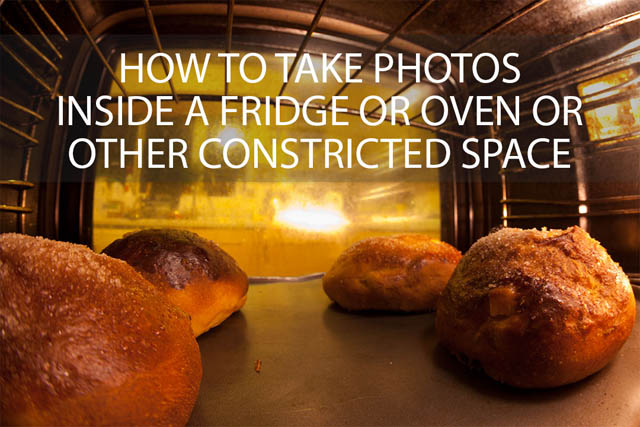
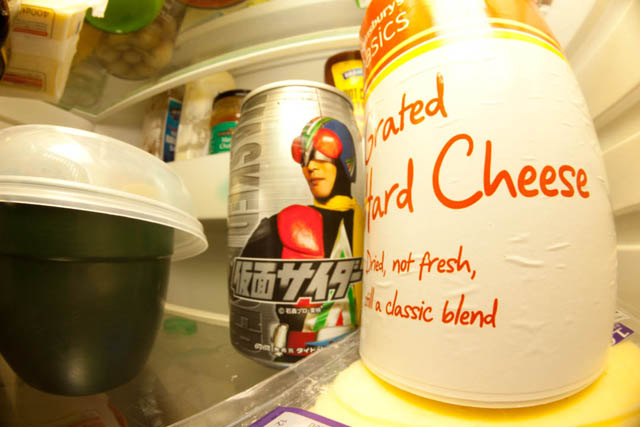
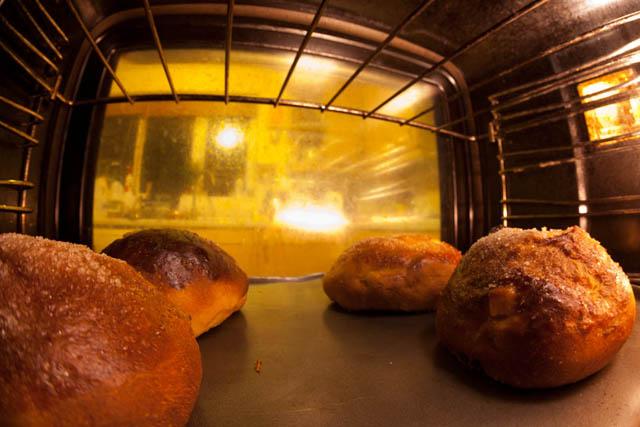
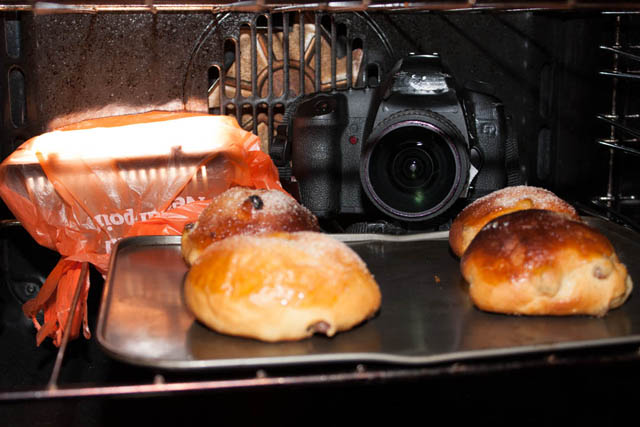





This is interesting, but I wonder how can I have a camera that can survive the extra water or heat inside a running appliance?
Most phones and cameras can survive refrigerators, freezers, and cupboards are OK to use camera inside them even when refrigerators and freezers are on. However,
The dishwasher and the clothes washer use hot water and detergent which usually destroy normal cameras, what camera/phone can you use for that?
The oven and the clothes dryer use high temperatures which usually destroy most cameras, so what camera/phone can be used for those appliances?
The last appliance that needs a very special camera would be the microwave oven, how can someone put a camera or phone inside a running microwave?
Would like to know if any such products phones/cameras exist in the market?
Hi Hashem
Thanks for the comment, I’ll try and edit the article because I didn’t make it very clear about the point.
I wouldn’t advise using your camera in an oven, especially not a microwave oven with the oven actually switched on. I’m not quite sure what would happen with a camera in a microwave oven, but I know they don’t like having any metal object inside them, likely it would fry the camera electronics at the least.
The trick is just to make it look like the device is on. You can see in the article I did this for the oven just by using an orange colored light. For a dishwasher or washing machine, you could try wetting everything and spreading some suds around. Then put your camera in place to take the photo.
Hi Hashem
Thanks again for the comment, I’ve now updated the article and added a few paragraphs to the end about making it look like the camera is in a device that is switched on.
I’m not aware of any ‘normal’ cameras designed for high heat. There are some specialist models available designed for monitoring inside furnaces, e.g. http://www.synfab.com/high-temperature-systems/
But GoPros can be used with their waterproof housing for wet photography. So long as you have the washing machine on a cool wash, it shouldn’t be too much of a problem. If you search the web for “gopro washing machine” you’ll find a few different videos where people have done this.
Regards
Dave